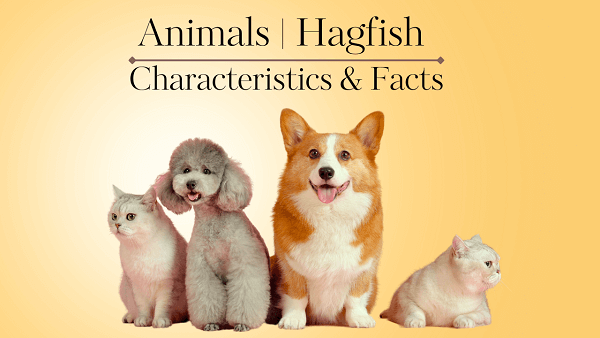Hagfish Definition | Characteristics & Facts
Home » Animals » Hagfish Definition | Characteristics & Facts
Hagfish Definition
Hagfish refers to a group of primitive marine creatures belonging to the class Myxini, which are often referred to as slime eels due to their elongated, eel-like bodies and ability to produce copious amounts of slime.
Characteristics & Facts
Taxonomy and Classification
Hagfish belong to the class Myxini, which is part of the jawless fish group.
They are often referred to as “living fossils” because they have remained relatively unchanged for millions of years.
Physical Characteristics
Hagfish have elongated, eel-like bodies that can range from about 12 to 18 inches (30 to 46 centimeters) in length. They lack true jaws, but they have a round, sucker-like mouth with a rasping tongue-like structure called a radula.
Distribution and Habitat
Hagfish are found in cold, marine environments around the world, primarily in depths ranging from a few hundred to several thousand feet. They are commonly found in burrows on the ocean floor, in crevices, or rotting carcasses.
Feeding Habits
Hagfish are scavengers and feed primarily on dead or dying animals, including fish and marine invertebrates. They have a unique feeding mechanism where they enter a carcass through natural openings, such as the mouth or gills, and consume the soft tissues from the inside out.
Slime Production
One of the most remarkable characteristics of hagfish is their ability to produce copious amounts of slime. When threatened or disturbed, hagfish excrete a thick, gelatinous slime from specialized glands along their body.
Reproduction
Hagfish have separate sexes, with males and females both producing eggs and sperm.
Fertilization occurs externally, and the female hagfish can release hundreds of eggs into the water.
EcosystemHagfish
play an important ecological role by recycling nutrients in the deep-sea ecosystem through scavenging on dead organisms.
The slime they produce can also be beneficial, as it has antimicrobial properties that help prevent the decomposition of prey.
Economic Sigcenifican
Hagfish are harvested commercially for their skin, which is used in the production of high-quality leather. They are also used in the food industry, particularly in some Asian cuisines, where their meat is considered a delicacy.
Conservation Status
The conservation status of hagfish species varies, but some populations are threatened due to overfishing and habitat degradation.
Proper management and sustainable fishing practices are crucial to ensure the long-term viability of hagfish populations.
These are complete facts about hagfish, showcasing their unique characteristics and ecological significance in the marine ecosystem.
Read our Animals Encyclopedia with Complete Facts
Physical Characteristics of Hagfish
Body Shape: Hagfish have elongated, eel-like bodies with a slim and cylindrical shape. They lack paired fins, making their bodies streamlined for swimming through the water.
Skin and Slime: The skin of hagfish is smooth, slimy, and glandular. It secretes copious amounts of mucus or slime, which helps protect them from predators and aids in locomotion. The slime also contributes to their unique texture and appearance.
Eyes and Sensory Organs: Hagfish have small, primitive eyes that are covered with a layer of translucent skin. These eyes are rudimentary and lack lenses, limiting their visual capabilities. They rely more on other sensory systems, such as their sense of smell and touch.
Mouth and Jawlessness: They are jawless creatures. Instead of jaws, they possess a circular, muscular mouth surrounded by a ring of cartilage. This mouth contains rows of horny teeth on their specialized rasping tongue, called a “radula,” which they use to feed on carrion and other soft tissues.
Eel-Like Tail: They have a long, tapering tail that enables them to move efficiently through the water. The tail is their primary means of propulsion.
Lack of Vertebrae: Hagfish lack true vertebrae and a well-developed vertebral column or backbone. Instead, they have a primitive structure called a notochord, which provides some support to their bodies.
Coloration: Hagfish typically have a pale or pinkish coloration. However, their appearance can vary depending on the species and their surroundings.
Continue To Explore All Animals That Start With H
Scientific Classification
Kingdom: Animalia (Animals)
Phylum: Chordata (Chordates)
Class: Myxini (Hagfish)
View All A-Z Animals List
Hagfish FAQs
What does Hagfish Eat?
- Carrion
- Invertebrates
- Sediment-Associated Organisms
- Opportunistic Feeding
Explore More:
- Tarantula
- Mackerel
- Mackerel
- Sea Stars
- Bird
- Amphibians
- Vertebrates
- Sand Dollars
- Barnacles
- Scallop
- Brittle stars
- Tilapia
- Carp
- Krill
- Catfish
- Grouper
- Calm
- Yak
- Yucatan Brown Brocket
- White-tailed Deer
- Uakari
- Utahraptor (Dinosaur)
- Qinghai Lake Naked Carp
- Qilian Shrew
- Qinling Panda
- Qacha’s Nek long-fingered Frog
- Red Fox
- Red Panda
- Rockhopper Penguin
- Salamander
- Snail
- Storks
- Jacana
- Junglefowl
- Jabiru Stork
- Junco
- Japanese Crane
- Kudu
- Kingfisher
- Giant Stuffed Tiger
- Giant Stuffed Dolphin
- Giant Stuffed Bear
- Giant Stuffed Penguin
- Scrat (Ice Age)
- Freshwater Clams
- Water snakes
- Sphynx at
- Honeybees
- Parrots
- Caribou (also known as reindeer)
- Nemo (from Finding Nemo)
- Simba (from The Lion King)
- Pink Panther
- Garfield
- Blobfish
- Japanese giant salamander
- Vampire Bat
- Shark
- Crab
- Fennec Fox
- Gila Monster
- Sea Turtle


